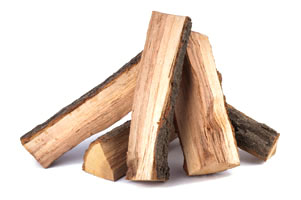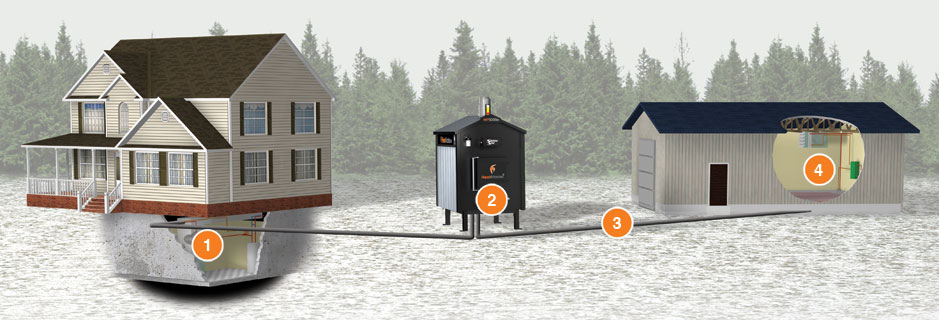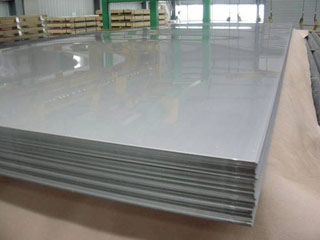- It’s better for your wallet – Reduces utility costs and virtually eliminates your heating bill.
- It’s better for your safety-By taking the risk of fire outside your home, it removes the dangers associated with indoor burning including chimney fires, carbon monoxide poisoning or oxygen depletion.
- It’s better for your health- Keeps all problems associated with indoor wood burning (smoke, ashes, odor, soot buildup, air quality) and indoor wood storage (bugs, rodents) outside and away from your home.
- It’s better for meeting all your heating needs- Can be used with most existing heating systems and has the ability to heat multiple buildings.
- It’s better for the environment – Burns all-natural fuels which are a renewable energy source, are in abundant supply and are often inexpensive or free.

There are many advantages to using an outdoor wood furnace:


1. Home
A HeatMasterss furnace can tie into your home heating system very effectively. The radiator element can be installed into the existing plenum of your furnace as well as the hot water system.

2. Furnace
Heatmasterss outdoor furnaces come with easy access rear doors and ball valves making plumbing and maintenance quick and easy. Insulated underground pipe enters the rear of the furnace through the floor and connects to the valves with pex or pex-al-pex plumbing fittings. The pump is installed on the supply outlet to push water to the building being heated. You can also adjust your air injection using the dampers on the fan box located on the back wall of the furnace to ensure maximum burn time and fuel efficiency.

3. Pipes
To heat the home or structure, the outdoor furnace pumps hot water indoors via insulated underground pipes. Once the water enters the structure, it travels through traditional heating systems, including a radiant baseboard, a forced-air furnace or a radiant floor system, and then circulates back to the furnace.

4. Outbuildings
The HeatMasterSS system is perfect for garages, shops and other outbuildings. It will power an overhead forced air heating unit or in-floor heating using a boiler.
An outdoor furnace is typically installed in your backyard, 25 to 300 feet away from the building or the structure you intend to heat.
Did You Know?
In addition to supplying heat and hot water to traditional sources, a HeatMasterss furnace can also:
– Supply heat for clothes dryers and baseboard heaters
– Act as a snow-melt for driveways
– Provide an unlimited source of hot water (pools, hot tubs, etc)
– Heat livestock structures such as dairy and hog barns

Why is 409 Stainless Steel the best choice for Outdoor Furnaces?
There is a lot of debate in the outdoor furnace industry about which steel is better to use.
We have made our choice based on the value that is provided to you, which is corrosion resistance, ability to withstand high temperatures, thermal expansion, heat transfer and cost effectiveness. Titanium Enhanced 409 Stainless Steel is our choice for good reason.
Heat Tolerance is what really sets 409 Stainless Steel apart from other steels in outdoor furnaces. It far outperforms all others steels and gives the furnace a long life. 409 Stainless Steel can withstand continuous temperatures of up to 1400º F while no other steel used in outdoor furnaces can withstand anything over 800ºF. This means that when the fire is over 800ºF mild steel will begin to oxidize and break down causing material failure which means a shorter life span.
Corrosion Resistance
Stainless Steel is stainless because it has a chromium oxide film added to the steel. This film keeps oxygen from penetrating and corroding the material (rusting) and it’s why you see mild steel rusting while sitting out in the open. Mild steel will begin corroding from the first day of use and this is why many mild steel furnaces are at least 1/4” thick (to try to give the more life span).
Heat Transfer
409 Stainless Steel has the best heat transfer capability of any stainless steel used in outdoor furnaces, having about 60% more heat transfer capability than 304 SS and a similar heat transfer capability to mild steel when factoring in the thickness of material necessary for mild steel furnaces.
Thermal Expansion/Warping
409 Stainless Steel outperforms all other stainless steels used in outdoor furnaces. It has a low expansion rate and consequently won’t warp or get spider cracks.
| Mild Steel | 409 SS | 304 SS | |
|---|---|---|---|
| Corrosion Resistance | No | Yes | Yes |
| Heat Transfer | Good | Good | Not Good |
| Thermal Expansion | Low | Low | High |
| Continuous Temperature Tolerance | 600-800° | 1400° | 800° |
| Cost | Good | Good | High |
